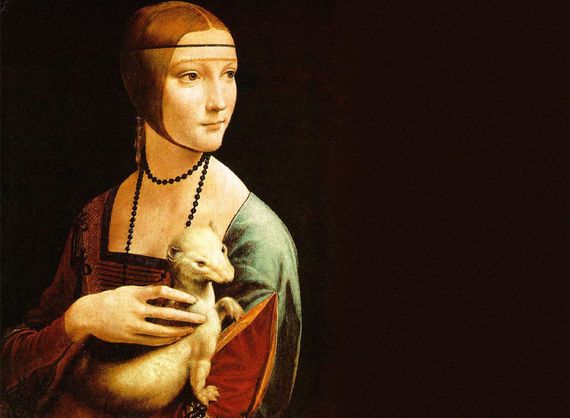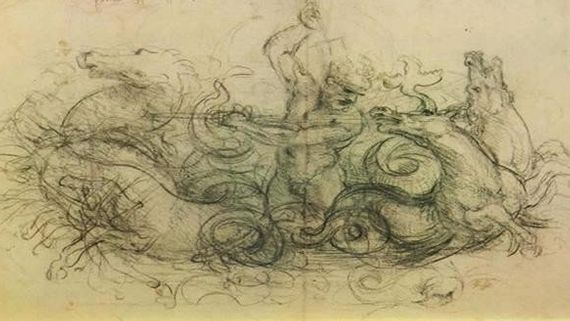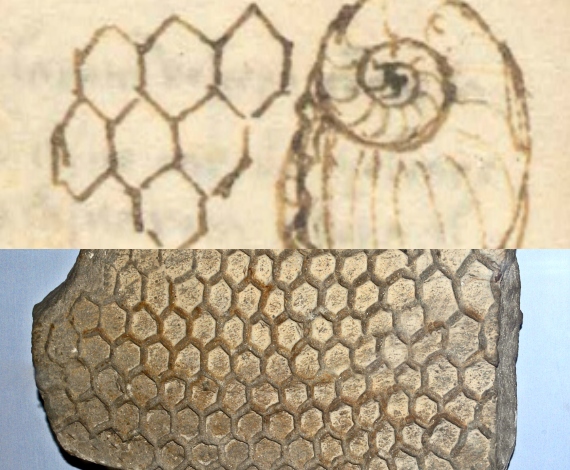It has been said of Leonardo da Vinci that his interests covered nearly everything: painting, drawing, sculpting, engineering, architecture, inventions, poetry, mathematics, physics, anatomy and so on, even music and cooking. However, his extensive studies on animals, the mark of a modern-day zoologist, have not received as much attention. His studies on animals were not restricted to existing animals, but also dwelt on imaginary animals or monsters, as well as on extinct species (through their fossils). May 2, 2019 is the 500th anniversary of his death in Amboise, France and an opportunity to examine the current relevance of his works and studies on animals.
Live animals
Leonardo left us an enormous wealth of his works, which range from his well-known paintings and drawings to his writings in various Codices 1.
To begin with, the animals in his paintings and drawings play a symbolic role. The animal in his “Lady of the Ermine” was most probably a white ferret, which is easier to house train and observe and would have been included in reference to Ludovico il Moro, Duke of Milan, who commissioned the painting for his mistress Cecilia Gallerine, subject of the painting and even as a symbol of purity and/or moderation. The Duke had just entered the Order of Saint Michael, also known as the Order of the Ermine and “gale” was the Greek word for the animal. Likewise, in his manuscripts he used many animals as symbols or allegories of human virtues and defects. He drew and wrote about lizards as symbols of fertility, doves as representing ungratefulness and eagles as figures of generosity and so on.

But Da Vinci also studied and represented animals for more practical reasons. His drawings of birds provided him with insight into flying machines. His studies of horses attempted to reveal the nature of movement, essential for a painter. His representations of dogs and cats also served as a study of the expression of emotions – what he called “the movements of the mind” – which he would later attempt to depict in his paintings.
Therefore, it can be said that, contrary to other great artists of his time, such as Michelangelo who focused more on the human figure, Leonardo was very interested in animals and studied them in depth. This may be due to a prophetic vision – pre-Darwin – of the unity and homology of all animals, including humans. This idea can be supported by his drawings comparing the anatomy of horse legs with human limbs. It is also in line with what he wrote explicitly in his manuscripts regarding the close relationship between humans and apes.
Fantastic and monstrous animals
Leonardo was a highly gifted observer of nature and a rationalist. However, in his paintings, drawings and, especially, his manuscripts, he also gave full rein to fantasy, including a variety of fantastic and monstrous animals.
In some of his works, he included fantastic animals that already existed in popular lore and in various cultural traditions. An example of this are the dragons that appear in his drawings beside cats and dogs or at the feet of equestrian figures. In addition, his Bestiary includes numerous fantastic animals more or less accepted before the time: unicorns, basilisks, sirens and so on.
In other works, he also included certain fantastic animals of his “own making”. Such is the case of the painting “Neptune and the Horses” – now lost but of which remains a drawing – in which the god of the seas rides a carriage pulled by sea horses with fish tails. These invented animals have a combination of physical traits of different animals that actually exist. They could be considered chimerical animals of his own invention.

This illustrious polymath also produced numerous drawings of monsters of beings more or less distorted or grotesque, working from creatures he could find in nature or those he heard stories of, including certain human beings, or simply a product of his personal fantasy.
When depicting these chimerical creatures, Da Vinci appears to show that there are no possible forms beyond those found in nature, although there may be combinations of these. His studies of “monsters” infer the rules that govern the formation of “normal” living beings. These ideas have been followed up on in scientific disciplines such as biology and developmental genetics.
In this area we should also mention the construction of the most “fantastic” animals of all, Leonardo’s mechanical lions, which lived on afterwards in numerous automatic applications and currently in robots.
Fossils
Leonardo was one of the first authors of the Renaissance to contribute to clarifying the nature of fossils 2. Before his time, there were two ideas that prevailed over the rest. One was that they were remains from the Biblical Flood that wiped out land creatures and pushed marine animals to the mountains from where they could not return to the sea when the waters receded. The other, more “Neo-Platonic” so to speak, believed they were attempts by nature to form non-organic mineral structures with the appearance of living creatures. There were a few others a bit more “crazy”, such as the belief that the fossils that appeared on mountains were the remains of giants’ meals.
Da Vinci carried out several studies that countered these “explanations” and were along the right path. He concluded that they were mineralized remains of animals – and evidently plants – that had lived on Earth at different times in the past. His writings on the subject were many, but noteworthy are his affirmations that fossils appear in different geological strata and not just one, that some fossils of bivalve animals appear intact on mountains – that is, with both valves – which is not compatible with violent displacement from a more or less faraway sea, that fossils do not appear in all types of rock, but only in those originating in the sea, etc.

Lastly and to be highlighted, a recent study has defended that one of Leonardo’s drawings includes the fossils of several animals – a series of hexagons that would represent a different type of fossil – one which represents the activity of an organism rather than the organism itself. These structures are currently known as trace fossils and Leonardo is considered the first person to have studied them and therefore the “father-founder” of the science that studies them, or Ichnology3; in fact, his hexagons have been classified in the genus Paleodictyon.
This has renewed interest in these hexagons and their origin, with the proposal of several hypotheses. Some consider them to be nests of certain unknown primitive organisms or tunnels they made for the growth of bacteria that they fed on. Others base their conclusions on the fact that these marine structures are also formed today in deep-sea beds (detected by the Alvin submarine) and consider that, rather than traces of past animal activity, they are the figures or marks of animals, no less enigmatic, that still exist: xenophyophores, giant protista related to foraminifera with a spongy appearance4.
BIBLIOGRAPHY
-
The Internet contains plenty of information on the figure and works of Leonardo. As regards his manuscripts, in the Miguel de Cervantes Virtual Library there is a text titled “Aphorisms/Leonardo da Vinci”, which contains all his work on animals, as well as on many other subjects. Two interesting books have also been published recently: one by W. Isaacson, Leonardo da Vinci. The Biography. Debate.2016 and another by J. Nathan and F. Zöllner. Leonardo da Vinci. The Complete Paintings and Drawings. Taschen. 2018.
-
The author who best portrayed Leonardo’s role in establishing the real nature of fossils is the great paleontologist S.J. Gould in the first chapter of his book “Leonardo’s Mountain of Clams” (Ed. Crítica 1999): The Upwardly Mobile Fossils of Leonardo’s Living Earth”. However, in this chapter, Gould explains that although Leonardo was right about the true nature of fossils, he did so within a theoretical context in which the Earth functioned like a human body – “charming but extremely antiquated”.
-
Baucon, A. Leonardo da Vinci, The Founding Father of Ichnology. Palaios, 2010, v.25: p. 361-365.
-
Barras, C. Leonardo fossil sketch may depict early nests. Nature, 16 Nov. 2012: doi.10.1038/nature.2012.11841; Rona, P.A. et al. Palaeodyction, A Living fossil on the Deep See Floor. American Geophysical Union, Fall Meeting 2003.
Comments on this publication